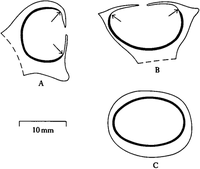Thermal Imaging and Pitvipers: Difference between revisions
No edit summary |
|||
| Line 38: | Line 38: | ||
Nautilus eyes consist of a 1 mm diameter pinhole opening up to a roughly 10 mm diameter cavity. The back of the cavity is lined with photoreceptors with a peak sensitivity to blue light at 465 nm, which makes sense given that only blue light reaches the 100+ meters of depth where the nautiluses live. | Nautilus eyes consist of a 1 mm diameter pinhole opening up to a roughly 10 mm diameter cavity. The back of the cavity is lined with photoreceptors with a peak sensitivity to blue light at 465 nm, which makes sense given that only blue light reaches the 100+ meters of depth where the nautiluses live. | ||
[[File:Nautilus_cross_section.png|200px| Raj 1984]] (Source: Raj 1984) | |||
To understand the limits to Nautilus vision, let’s examine the angular and spatial resolution of pinhole eyes.The visual resolution of pinhole eyes is a combination of the aperture size (D) and its distance from the retina (h). | |||
The geometrical blur of a large aperture <math> \theta_{aperture} = sin^{-1}\frac{D}{h} </math>, the diffraction blur (Airy disk half angle) <math> \theta_{diffraction} = sin^{-1}1/22\frac{\lambda}{D} </math>. We can also project the angular resolution onto the back of the retina to get the spatial resolution from the spot size <math> dx = h sin\theta </math>. The intensity of light on the detector is a fraction of the ambient intensity <math> I_{det} = 2 sin^2 \frac{\theta_{aperture}}{4} I_{ambient}</math>, so therefore there is a direct tradeoff between resolution and sensitivity. To summarize, larger apertures increase blurring due to the aperture size, decrease blurring due to diffraction, and increase the amount of light collected. | |||
[[File:eq_pinhole.png|200px]] | |||
=== Infrared === | === Infrared === | ||
[[File:Kuffler_excitatory.png|200px]] | |||
[[File:Snake_excitatory.png|200px]] | |||
== Methods == | == Methods == | ||
| Line 54: | Line 67: | ||
You can write math equations as follows: | You can write math equations as follows: | ||
<math>y = x + 5 </math> | <math>y = x + 5 </math> | ||
<math> </math> | |||
You can include images as follows (you will need to upload the image first using the toolbox on the left bar, using the "Upload file" link). | You can include images as follows (you will need to upload the image first using the toolbox on the left bar, using the "Upload file" link). | ||
Revision as of 16:29, 18 December 2023
Introduction
Electromagnetic radiation refers to traveling oscillations in the electric and magnetic fields. The name “electromagnetic radiation” has about nine syllables too many, so in physics it is often simply called “light”. Light can be categorized based on the portion of the electromagnetic spectrum it resides in (e.g. “visible light”) or it can be categorized based on its source (e.g. “laser light”). In this report we will refer to two regions of the spectrum - the “visible” and the “infrared”. The visible region is the portion our eyes can see and consists of wavelengths 400 - 700 nm. The infrared region is everything between the visible and microwave portions of the spectrum, or wavelengths roughly from 700 nm - 1 mm. We will focus on light generated by the thermal motion of particles, which we call “thermal light”.
Although different portions of the electromagnetic spectrum often are treated as completely separate, we will show here that both the visible and infrared are used by animals for vision. Our goal is to understand the components fundamental to imaging in these two wavelength regions and to connect the animals’ vision to today’s technology.
We first briefly introduce the origins of thermal light. Then we will discuss the evolution of vision in animals to both the visible and the infrared, before comparing the two and noting the implications for human camera technology in the two regions of the spectrum.
Background
Scientists observed that warm things emitted light, and then tried to model it. In 1900 Max Planck was shown data on the spectrum of thermal light, and the same day guessed a formula that modeled it. He started with the answer and then worked backwards to explain it, changing any physics that disagreed along the way - in doing so he invented the Boltzmann constant and also quantized the energy levels of the light - marking the very beginning of quantum mechanics [Hollandt 2012]. His equation for the spectrum of thermal light emitted by an object at temperature T is [Planck 1910]
![]()
There are no geometrical terms here - the object is assumed to be a “blackbody” that perfectly absorbs all incident light, and thus also perfectly emits thermal light. Most everyday objects are not perfect absorbers, but instead are partially reflective. We can model these “greybodies” by multiplying the blackbody spectrum by the emissivity - a number between 0 and 1 that represents how absorptive or emissive the object is. In general, the emissivity depends on wavelength and angle, but oftentimes an average emissivity is sufficient.
By integrating the greybody intensity spectrum we find that the power of thermal radiation scales with temperature to the fourth power times the emissivity.

![]()
![]()
![]()
To summarize, everything emits thermal light, with a spectrum and radiance that depends on material and temperature. The sun has a temperature of about 6000 K and emits light with a peak wavelength in the visible around 500 nm. Everything at earth-scale temperatures near 300 K emits in the infrared with a peak wavelength around 10 um.
Vision in Animals
Most animals need to perceive their environment in order to find food and avoid predators. Animals evolved the ability to sense light from the environment, multiple times, in order to better perceive the environment. In this section, we will discuss two different kinds of vision in the animal kingdom. First, we talk about vision with visible light, which detects the reflections of sunlight off the surroundings. Then we talk about vision with infrared light, which detects the thermal light emitted by the surroundings.
Visible
Vision first evolved about 500 million years ago during the Cambrian period, a time when all life was underwater. It is thought that the first eyes consisted of photoreceptors and had only light/dark sensitivity. Gradually, some eyes became dimpled to form pinhole cameras and therefore acquired spatial resolution. The pinhole aperture eventually became sealed by a cornea and the lenses we know and have today evolved. Some animals, however, never evolved lensed eyes and remain virtually unchanged since the Cambrian. The nautilus is one such living fossil that provides a glimpse of what some early eyes looked like.
 (Source: Monterey Bay Aquarium)
(Source: Monterey Bay Aquarium)
Nautilus eyes consist of a 1 mm diameter pinhole opening up to a roughly 10 mm diameter cavity. The back of the cavity is lined with photoreceptors with a peak sensitivity to blue light at 465 nm, which makes sense given that only blue light reaches the 100+ meters of depth where the nautiluses live.
To understand the limits to Nautilus vision, let’s examine the angular and spatial resolution of pinhole eyes.The visual resolution of pinhole eyes is a combination of the aperture size (D) and its distance from the retina (h). The geometrical blur of a large aperture , the diffraction blur (Airy disk half angle) . We can also project the angular resolution onto the back of the retina to get the spatial resolution from the spot size . The intensity of light on the detector is a fraction of the ambient intensity , so therefore there is a direct tradeoff between resolution and sensitivity. To summarize, larger apertures increase blurring due to the aperture size, decrease blurring due to diffraction, and increase the amount of light collected.
Infrared
Methods
Results
Conclusions
References
Appendix
You can write math equations as follows:
You can include images as follows (you will need to upload the image first using the toolbox on the left bar, using the "Upload file" link).










